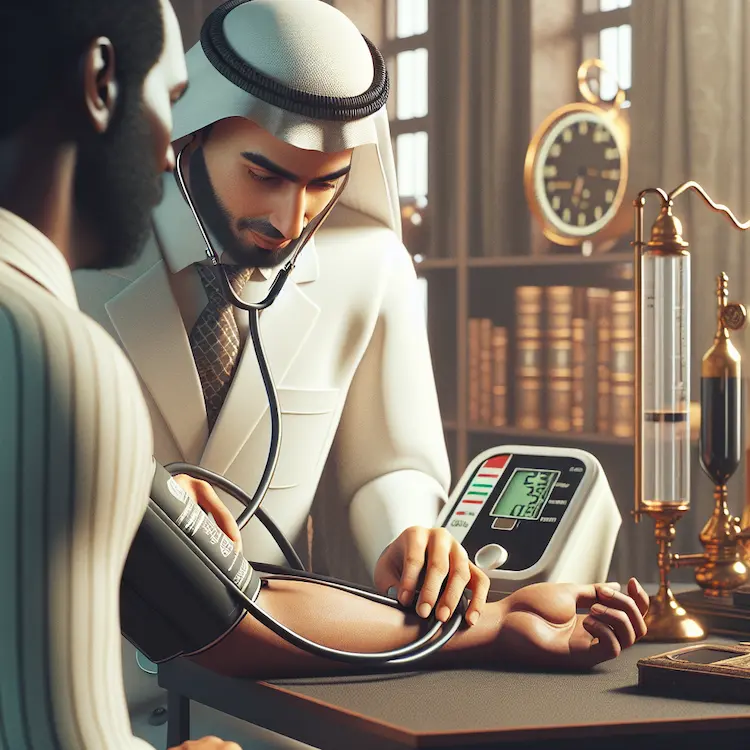Blood pressure monitoring has become an essential tool in modern healthcare, playing a crucial role in the diagnosis and management of cardiovascular diseases. The journey from rudimentary observations to sophisticated digital devices spans several centuries, marked by groundbreaking discoveries and technological innovations. This article explores the fascinating history of blood pressure monitoring, its evolution, and its impact on medical practice and public health.
The foundation for understanding blood pressure was laid in the early 17th century when William Harvey discovered blood circulation in 1628. This groundbreaking work, published in his treatise “Exercitatio Anatomica de Motu Cordis et Sanguinis in Animalibus,” described the heart as a pump and arteries and veins as vessels carrying blood. Harvey’s discovery was a pivotal moment in medical history, setting the stage for future advancements in cardiovascular research.
The first recorded attempt to measure blood pressure came nearly a century after Harvey’s discovery. In 1727, Stephen Hales, an English clergyman and physiologist, conducted a remarkable experiment. He inserted a brass pipe into the crural artery of a horse and connected it to a glass tube. Hales observed that the blood rose to a height of 8 feet and 3 inches above the left ventricle of the heart, oscillating with each heartbeat. This crude but ingenious method provided the first quantitative measurement of blood pressure.

The 19th century saw significant advancements in blood pressure measurement techniques. In 1855, Karl von Vierordt proposed that blood pressure could be measured non-invasively by compressing arteries with weights. Although his method was impractical, it laid the groundwork for future non-invasive techniques.
Étienne Jules Marey improved upon Vierordt’s design in 1860 by introducing the sphygmograph. This device used a water-filled chamber to compress the artery and a manometer to record blood pressure. While more accurate than previous methods, it was still complex and not widely adopted.
The modern era of blood pressure measurement began with the invention of the sphygmomanometer. In 1881, Samuel Siegfried Karl Ritter von Basch developed the first sphygmomanometer, which used a water-filled bag connected to a mercury column. This device marked a significant improvement in accuracy and ease of use.
A major breakthrough came in 1896 when Scipione Riva-Rocci introduced his version of the sphygmomanometer. His design featured an inflatable cuff that encircled the entire arm, connected to a mercury manometer. This method allowed for more consistent and accurate measurements of systolic blood pressure. Riva-Rocci’s design forms the basis of modern blood pressure measurement techniques.
The ability to measure both systolic and diastolic blood pressure came with Nikolai Korotkoff’s discovery in 1905. Korotkoff, a Russian surgeon, described the sounds (now known as Korotkoff sounds) heard through a stethoscope as the cuff pressure is slowly released. This method allowed for the determination of both systolic and diastolic pressures, providing a more complete picture of cardiovascular health.
For much of the 20th century, mercury sphygmomanometers were the gold standard for blood pressure measurement. Their accuracy and reliability made them the preferred choice in clinical settings. However, concerns about mercury toxicity have led to their gradual phasing out in many countries.
Aneroid sphygmomanometers, which use a mechanical system instead of mercury, gained popularity as an alternative to mercury devices. These instruments are more portable and environmentally friendly but require regular calibration to maintain accuracy.
The development of oscillometric devices in the late 20th century revolutionized blood pressure monitoring. These automated devices detect oscillations in the arterial wall to determine blood pressure, eliminating the need for auscultation. Oscillometric devices have made home blood pressure monitoring widely accessible and have enabled the development of 24-hour ambulatory blood pressure monitoring.

Traditional office blood pressure measurement remains a standard practice in clinical settings. However, it’s recognized that office readings can be affected by various factors, including white coat hypertension.
Home blood pressure monitoring has become increasingly popular, allowing patients to track their blood pressure over time in their natural environment. This method provides valuable data for healthcare providers and helps in the management of hypertension.
24-hour ambulatory blood pressure monitoring offers a comprehensive view of a patient’s blood pressure throughout the day and night. This technique is particularly useful in diagnosing masked hypertension and assessing the effectiveness of antihypertensive treatments.
Understanding and monitoring blood pressure has had a profound impact on public health. Hypertension is a major risk factor for cardiovascular diseases, which are leading causes of death globally. Regular blood pressure monitoring allows for early detection and management of hypertension, potentially preventing serious complications.
| Technique | Advantages | Disadvantages |
|---|---|---|
| Mercury Sphygmomanometer | High accuracy, gold standard | Environmental concerns, requires training |
| Aneroid Sphygmomanometer | Portable, no mercury | Requires regular calibration |
| Oscillometric Devices | Automated, easy to use | May be less accurate in certain populations |
| Home BP Monitoring | Convenient, multiple readings | Requires patient education |
| Ambulatory BP Monitoring | Comprehensive 24-hour data | More expensive, can be uncomfortable |
The future of blood pressure monitoring is moving towards more continuous, non-invasive methods. Wearable devices and cuffless technologies are being developed to provide real-time blood pressure data without the need for traditional cuff-based measurements. These advancements promise to improve our understanding of blood pressure variability and its impact on health.
The history of blood pressure monitoring reflects the broader evolution of medical science and technology. From Hales’ horse experiment to modern wearable devices, each advancement has contributed to our understanding of cardiovascular health. As we continue to refine measurement techniques and expand access to monitoring tools, the potential for improving global cardiovascular health grows. Regular blood pressure monitoring, whether at home or in clinical settings, remains a cornerstone of preventive healthcare and a powerful tool in the fight against cardiovascular disease.